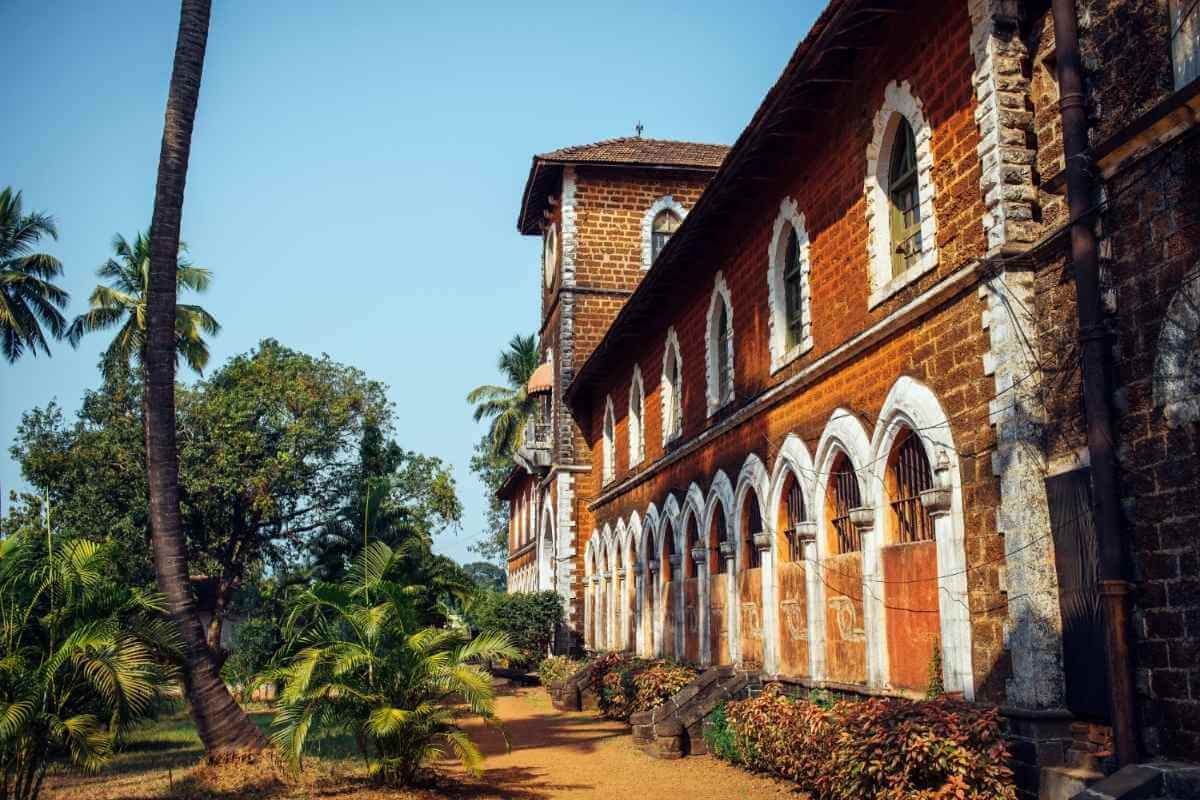Goa, the picturesque coastal state of India, is not only known for its stunning beaches, vibrant culture, and laid-back lifestyle but also for its unique and mesmerizing architecture. Whether you are a first-time visitor or a long-time resident, it is impossible to miss the distinctiveness of Goan homes and buildings. From the quaint houses tucked away in the village lanes to the imposing churches scattered across the state, Goan architecture tells a story of its colonial past, cultural amalgamation, and adaptation to local climate conditions. The charming architecture of Goa stands out as a true testament to the region’s history and its ability to merge foreign influences with indigenous traditions.
The Birth of Goan Architecture
Goan architecture as we see it today owes much of its origin to Portuguese colonization, which began in 1510. The Portuguese arrived in Goa with their own cultural ideals and ambitions, aiming to spread Christianity and establish dominance over the region. One of the first things the Portuguese implemented was the construction of churches, a strategy to convert the local population. These churches were built in the Portuguese-Manueline style, marked by a fusion of Gothic and Moorish elements, which set the foundation for Goan architecture.
Over time, the Portuguese influence expanded beyond religious buildings and into domestic architecture. As they began to establish homes and fortresses along the coast, they fused their European architectural techniques with traditional Indian elements. This synthesis created an architectural style that was distinctly Goan, characterized by spacious, airy houses that reflected the tropical climate, as well as the opulence of colonial power. The use of laterite stone, ornate designs, and vibrant color schemes became integral to the Goan architectural identity.
Distinctive Features of Goan Architecture
Goan architecture is more than just aesthetically pleasing; it is a blend of practicality and cultural symbolism. While many of the buildings bear the stamp of Portuguese influence, they also incorporate indigenous elements, making them unique to Goa.
The Churches of Goa
The churches of Goa are perhaps the most iconic representation of its architectural heritage. These structures, many of which date back to the 16th and 17th centuries, retain their original Portuguese-Manueline designs. The famous churches, such as the Basilica of Bom Jesus and Se Cathedral, are built using laterite stone and lime plaster, with intricate detailing and delicate carvings. Their interiors, adorned with Baroque altars, painted ceilings, and gilded woodwork, exude a sense of grandeur and spiritual beauty.
Goan churches are a reflection of the fusion between Portuguese religious designs and local building materials, resulting in some of the most awe-inspiring places of worship in India. They also represent the blending of Goa’s Hindu and Christian cultures, with features like the wooden altars and delicate carvings inspired by indigenous Indian craftsmanship.
The Exteriors of Goan Homes
One of the most striking aspects of Goan architecture is the exterior of its houses. The vibrancy of colors is immediately noticeable—houses are painted in bright hues like terracotta, yellow, green, and blue. The bold use of colors is not merely for aesthetic purposes; it serves a functional purpose as well. The tropical climate in Goa is characterized by intense heat and humidity, and these colors reflect the sunlight, helping to cool the interiors of homes. Additionally, the elevated ceilings and large windows in Goan houses allow for maximum airflow, keeping the interiors airy and comfortable.
The exteriors also feature large courtyards or verandas, often with beautiful decorative iron railings, and sometimes even intricate tiles. The traditional Goan home is built to withstand the region’s unique climate and weather conditions, offering comfort and shelter while also celebrating local craftsmanship and artistry.
Oyster Shell Windowpanes
A defining characteristic of many traditional Goan homes is the use of oyster shell windowpanes. These charming window designs are a product of Goa’s fishing community, which historically relied on the sea for sustenance. Oysters were harvested by the fishermen and used to craft the distinctive semi-circular top windows, often framed with rectangular sections and small look-out squares in between.
While these oyster shell windows are becoming rare due to modern construction methods and conservation initiatives, they remain an important part of Goan architectural heritage. These windows not only reflect Goa’s maritime history but also provide practical benefits—allowing for air circulation while protecting against the harsh sun.
Balcao (Traditional Balcony)
The balcao is a hallmark of traditional Goan architecture, often seen in older Catholic homes. This outdoor porch or balcony was a social space where families would relax, socialize, and engage with the community. The balcao is typically adorned with colorful concrete seating, making it a vibrant and inviting space that bridges the gap between the house and the street. It is an ideal spot to enjoy a cup of tea, watch the world go by, or have a conversation with neighbors.
The balcao has a dual purpose—acting as an extension of the living space while also serving as a way for homeowners to engage with the broader community. This open, communal style of living is central to Goan life and reflects the state’s laid-back, sociable culture.
Azulejo Tiles: The Enchanting Nameplates
The azulejo tiles are another integral aspect of Goan architectural heritage. These beautifully hand-painted ceramic tiles, often blue and white, were introduced by the Portuguese and are now synonymous with Goan homes. These tiles are used as decorative pieces, often adorning the walls of homes and serving as both artistic and functional elements. Many homes have custom-made azulejo tiles with names, symbols, or other personalized motifs that add a unique touch to the structure.
While modern production methods have replaced the traditional hand-painting process, these tiles still hold immense cultural value and can be found in homes, churches, and public spaces throughout Goa.
The Tulsi Plant in the Veranda
For Hindu Goan families, the presence of the Tulsi (basil) plant in the veranda is almost a sacred requirement. The Tulsi plant is central to Hindu rituals and is revered for its spiritual significance. In traditional Goan homes, the plant is placed in the center of the veranda, where it is cared for and tended to as part of daily rituals. The Tulsi Vivaah, a ceremony celebrating the marriage of the Tulsi plant to Lord Vishnu, is often performed, making the plant a vital symbol of family life and devotion in Goan homes.
Preserving Goan Architecture
The preservation of Goan architecture has become a significant concern as modern development encroaches upon the state’s historical structures. Several conservation projects and initiatives have been launched to protect the architectural heritage of Goa and prevent the destruction of its cultural landmarks. The use of traditional building materials, expert craftsmanship, and local knowledge is essential for ensuring that the true essence of Goan architecture is preserved for future generations.
It is important for both locals and visitors to recognize the value of preserving these historical buildings, which reflect the rich cultural tapestry of Goa. Modern architecture can coexist with traditional styles, but it is essential to strike a balance between progress and preservation to maintain the state’s architectural legacy.
Conclusion
Goan architecture is a unique blend of Portuguese colonial influence and indigenous Indian design, creating a style that is unlike any other state in India. From the vibrant exteriors of traditional houses to the iconic churches and charming oyster shell windows, every aspect of Goan architecture tells a story of cultural fusion, adaptation, and resilience. As Goa continues to develop, it is vital to preserve these architectural gems, ensuring that the state’s rich history and heritage remain an integral part of its identity for generations to come.


























20 thoughts on “Colonial Architecture: What Makes Goan Architecture Unique in India”
Free article directory. publish your articles for free https://write-for-us.org/
먹튀감정사는 카지노사이트의 신뢰도를 수치화하여 안전성을 보장합니다.
Nude Model Photo Gallery: https://pix.it.com/
Hi my loved one I wish to say that this post is amazing nice written and include approximately all vital infos Id like to peer more posts like this
This is one of the most well-rounded and in-depth posts I’ve come across on this topic. You’ve covered all the key points and provided enough detail to make the material truly valuable. I’m especially impressed by how you’ve managed to keep the tone accessible while still being thorough in your analysis.
Your posts are always so full of wisdom and practical advice.
You’ve done an amazing job with this article.
I really enjoyed reading this post. The way you’ve structured it makes it easy to follow, and I love how you’ve used real-life examples to bring the concepts to life. I feel like I’ve learned so much in just a short amount of time.
I’m definitely bookmarking this for later!
먹튀검증커뮤니티된 사이트에서 안전한 베팅을 즐기세요.
먹튀검증 커뮤니티된 사이트에서 안전한 베팅을 즐기세요.
FAP SLIDES – Distraction Free Slideshow https://fapslides.com/
먹튀검증 전문가들이 직접 검토한 먹튀검증소 웹사이트를 확인해보세요.
FAP SLIDES – Distraction Free Slideshow https://fapslides.com/
최신 캡주소 정보를 찾고 계신가요? CabPortal에서 신뢰할 수 있는 캡사이트와 캡도메인 정보를 빠르게 확인하세요!
탑플레이어포커머니상: www.탑플레이어포커머니상.site
check out these great images https://imgsrc.me/latest.php
테더환전 https://www.tetherexchange.net/
믿을 수 있는 토토커뮤니티
You’ve really done your research, this is great!